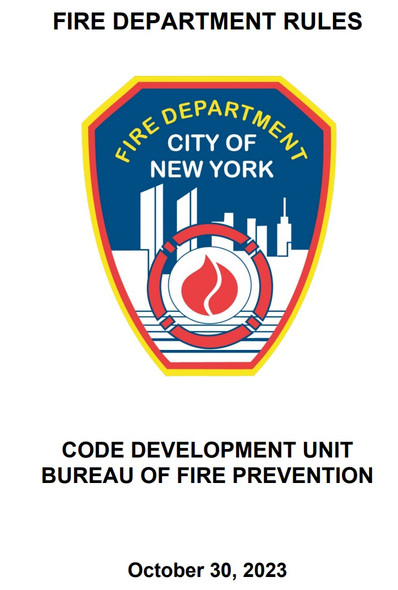hpdsigns.nyc
Fire Escape Drop Ladder NYC (pdf)
- SKU:
- Fire Escape Drop Ladder NYC (pdf)
- MPN:
- Fire Escape Drop Ladder NYC
Description
In pre-war New York City, the most common type of fire escape was the drop ladder system. This design featured a series of horizontal platforms—one at each story—connected by ladders or stairs. The lowest platform was equipped with a drop ladder that could be released to extend to the ground, providing an emergency exit for occupants.
Key Features of Pre-War Drop Ladder Fire Escapes:
- Materials: Constructed primarily from wrought or cast iron, these fire escapes were durable and capable of withstanding the elements.
- Design: The drop ladder was typically held in a retracted position when not in use and could be released to drop down to street level during an emergency. This design prevented unauthorized access from the ground while ensuring accessibility when needed.
- Installation: These fire escapes were mounted on the exterior of buildings, often facing the street or alleyways, and were a common feature of tenement buildings constructed during the late 19th and early 20th centuries.
Over time, building codes evolved, and the use of exterior fire escapes, including drop ladders, became less common in favor of interior stairwells and other fire safety measures. However, many of these historic fire escapes remain a distinctive feature of New York City's architectural landscape.
Fire Escape Drop Ladder FDNY Rules and Regulations
In New York City, the design, installation, and maintenance of fire escape systems, including drop ladders, are governed by the New York City Building Code and the Fire Department of New York (FDNY) regulations. These codes ensure that fire escapes provide safe and reliable means of egress during emergencies.
Key Requirements for Fire Escape Drop Ladders:
- Design and Construction
- Non-Combustible Materials: All components, including the drop ladder and the "shoe" at the bottom, must be constructed from non-combustible materials such as steel or wrought iron.
- Drop Ladder Mechanism: The ladder should be designed to be easily operable from the fire escape platform without the need for special tools. It must be capable of being deployed quickly and safely.
- Shoe (Bottom Part): The "shoe" is the bottom segment that makes contact with the ground. It must be securely attached to the ladder's stringers and designed to provide stable footing, preventing slipping or movement during use.
- Dimensions and Specifications
- Width: The ladder must have a minimum clear width of 18 inches between stringers.
- Rung Spacing: Rungs should be uniformly spaced, not more than 12 inches apart, and designed with non-slip surfaces.
- Clearance: There should be at least 4 inches of clearance behind each rung to allow a secure foothold.
- Installation
- Positioning: The drop ladder must be accessible from the fire escape balcony and should not be obstructed by architectural features or building elements.
- Guides and Supports: The ladder should slide smoothly within guides constructed of angle iron, typically 1½ inches by 1½ inches by ¼ inch, placed at least 21 inches apart.
- Operation: Counterbalance mechanisms are often used to ensure the ladder can be easily lowered by a person of average strength.
- Maintenance
- Regular Inspections: Fire escapes must be inspected at least every five years by a qualified professional to ensure they are in good working condition.
- Repairs: Any defects identified during inspections must be repaired promptly to maintain safety standards.
- Obstruction-Free: The operation of the drop ladder must not be impeded by any obstructions, such as awnings, signage, or stored items.
- Compliance with Codes
- New York City Building Code (Chapter 10 - Means of Egress): Outlines the requirements for exterior stairways and fire escapes, including dimensions, materials, and load capacities.
- FDNY Regulations: The FDNY may have additional requirements or interpretations, particularly regarding maintenance and emergency accessibility.
------------------
New York Consolidated Laws, Multiple Dwelling Law (MDW) § 53: Fire-Escapes outlines the requirements for the installation, design, and maintenance of fire escapes in multiple dwellings to ensure occupant safety. Key provisions include:
- Access: Fire escapes must be accessible from a living room or private hall within each apartment, excluding stair hall windows. Access should not be obstructed by fixtures or other impediments.
- Location: Fire escapes can be installed on walls facing streets or yards, in specific types of courts, or in designated recesses, adhering to defined spatial requirements.
- Projection and Height: Fire escapes must not project more than 4.5 feet into a public highway and should be at least 10 feet above any sidewalk directly below.
- Construction: They should be constructed of open balconies and stairways made of iron or stone, capable of sustaining a load of at least 80 pounds per square foot. The use of old materials or cast iron is prohibited.
- Drop Ladders: A drop ladder, 15 inches in width and of sufficient length to reach a safe landing place beneath, must be provided from the lowest balcony. The distance from the lowest balcony to the ground should not exceed 16 feet, with certain exceptions.
- Maintenance: Owners are responsible for keeping fire escapes in good order and repair. Obstructions or encumbrances on fire escapes are prohibited, and violations may result in misdemeanor charges.
These regulations are designed to ensure that fire escapes provide a reliable means
Legal Disclaimer
Business Representation We are a small, family-owned and operated business based in Brooklyn, New York. Please note that we are not affiliated with, sponsored by, or connected to the City of New York or any of its agencies. The website, products, services, and any hyperlinks found on our website are not endorsed by, approved by the City of New York or any of its agencies, including but not limited to the New York City Department of Housing Preservation and Development (HPD), Department of Buildings (DOB), Department of Transportation (DOT), Department of Sanitation (DSNY), and the Fire Department of New York (FDNY). We are also not affiliated with any federal, state, or local government agencies in any way.
Disclaimer of Legal Accuracy and Timeliness The information, codes, and due dates provided on this website or any related documentation may not be the most up-to-date version. Laws, regulations, and requirements may change, and the information here may not reflect the most current version. It is the user’s responsibility to verify the accuracy, completeness, and adequacy of the information contained on this site or any information linked to government sites. We do not guarantee or warrant the accuracy of the information presented, and we encourage you to check with official sources, such as state or federal agencies, for the most current information.
User Responsibility for Compliance Please note that legal requirements can vary based on your location and intended use of the products or services. It is solely the responsibility of the customer or user to ensure that they are in compliance with all applicable state, federal, local, and municipal laws and regulations. We make no warranty or representation regarding the suitability or sufficiency of the information provided on this website, including its use in compliance with any law.
No Legal or Professional Advice The information provided on this website and in any related materials is intended for general informational purposes only. It should not be interpreted as legal advice, professional advice, or a statement of law. For specific legal guidance or advice regarding your situation, we recommend consulting with a qualified attorney or other professional.
For more detailed information, please refer directly to the applicable laws and regulations for your state, city, and municipality.
























